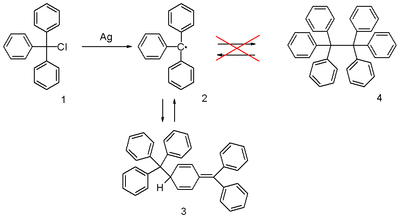
| |

| |
| Names | |
|---|---|
| Preferred IUPAC name
Triphenylmethyl | |
| Identifiers | |
3D model (JSmol)
|
|
| ChemSpider | |
PubChem CID
|
|
| |
| |
| Properties | |
| C19H15 | |
| Molar mass | 243.329 g·mol−1 |
Except where otherwise noted, data are given for materials in their standard state (at 25 °C [77 °F], 100 kPa).
| |
The triphenylmethyl radical (often shorted to trityl radical) is an organic compound with the formula (C6H5)3C. It is a persistent radical. It was the first radical ever to be described in organic chemistry. Because of its accessibility, the trityl radical has been heavily exploited.[1]
YouTube Encyclopedic
-
1/3Views:63818 5957 258
-
Steric Inhibition of Resonance ! Triphenylmethyl carbanion is non-planar
-
Organic Chemistry 51C. Lecture 02. Reactivity of Carbonyl Compounds.
-
Radicals - Drawing Resonance Structures 003
Transcription
Preparation and properties
It can be prepared by homolysis of triphenylmethyl chloride 1 by a metal like silver or zinc in benzene or diethyl ether. The radical 2 forms a chemical equilibrium with the quinoid-type dimer 3 (Gomberg's dimer). In benzene the concentration of the radical is 2%.[2]

Solutions containing the radical are yellow; when the temperature of the solution is raised, the yellow color becomes more intense as the equilibrium is shifted in favor of the radical (in accordance with Le Chatelier's principle).
When exposed to air, the radical rapidly oxidizes to the peroxide, and the color of the solution changes from yellow to colorless. Likewise, the radical reacts with iodine to triphenylmethyl iodide.

While the trityl radical forms a quinoid dimer, derivatives thereof with the appropriate substitution pattern do form dimers with a hexaphenylethane structure. X-ray studies give a bond length of 1.67 Å for hexakis(3,5-di-t-butylphenyl)ethane. Theoretical calculations on a very high level of theory indicate that van der Waals attraction between the tert-butyl groups create a potential minimum that is absent in the unsubstituted molecule.[3][4] Other derivatives have been reported as the quinoid dimer [5]
History
The radical was discovered by Moses Gomberg in 1900 at the University of Michigan.[6][7][8] He tried to prepare hexaphenylethane from triphenylmethyl chloride and zinc in benzene in a Wurtz reaction and found that the product, based on its behaviour towards iodine and oxygen, was far more reactive than anticipated. The discovered structure was used in the development of ESR spectroscopy and confirmed by it.[9][10][11]
The correct quinoid structure for the dimer was suggested as early as 1904 but this structure was soon after abandoned by the scientific community in favor of hexaphenylethane (4).[12] It subsequently took until 1968 for its rediscovery when researchers at the Vrije Universiteit Amsterdam published proton NMR data.[13]
See also
References
- ^ Tidwell, Thomas T. (2010). "Triarylmethyl and Related Radicals". Stable Radicals. pp. 1–31. doi:10.1002/9780470666975.ch1. ISBN 9780470666975.
- ^ Smith, Michael B.; March, Jerry (2007), Advanced Organic Chemistry: Reactions, Mechanisms, and Structure (6th ed.), New York: Wiley-Interscience, ISBN 978-0-471-72091-1
- ^ Lewars, Errol (2008), "8. Hexaphenylethane", Modeling Marvels, Springer, Bibcode:2008moma.book.....L
- ^ Grimme, Stefan; Schreiner, Peter R. (2011). "Steric crowding can stabilize a labile molecule: Solving the hexaphenylethane riddle". Angewandte Chemie International Edition. 50 (52): 12639–12642. doi:10.1002/anie.201103615. PMID 22025456.
- ^ Uchimura, Y.; Takeda, T.; Katoono, R.; Fujiwara, K.; Suzuki, T. (2015). "New Insights into the Hexaphenylethane Riddle: Formation of an α,o-Dimer". Angewandte Chemie International Edition. 54 (13): 4010–4013. doi:10.1002/anie.201500122. PMID 25704856.
- ^ Gomberg, M. (1900). "An instance of trivalent carbon: triphenylmethyl". Journal of the American Chemical Society. 22 (11): 757–771. doi:10.1021/ja02049a006.
- ^ Gomberg, M. (1901). "On trivalent carbon". Journal of the American Chemical Society. 23 (7): 496–502. doi:10.1021/ja02033a015. (Note: radical is also called a cadicle.)
- ^ Gomberg, M. (1902). "On trivalent carbon". Journal of the American Chemical Society. 24 (7): 597–628. doi:10.1021/ja02021a001.
- ^ Weissman, S. I.; Sowden, John C. (1953). "Electron distribution in triphenylmethyl: Hyperfine structure of the paramagnetic resonance absorption of (C6H5)3C13*". Journal of the American Chemical Society. 75 (2): 503. doi:10.1021/ja01098a522.
- ^ Sinclair, J.; Kivelson, D. (1968). "Electron spin resonance studies of substituted triphenylmethyl radicals". Journal of the American Chemical Society. 90 (19): 5074–5080. doi:10.1021/ja01021a004.
- ^ "ESR spectrum of the triphenylmethyl radical". School of Chemistry, University of Bristol. Retrieved August 5, 2018.
- ^ McBride, J. M. (1974). "The hexaphenylethane riddle". Tetrahedron. 30 (14): 2009–2022. doi:10.1016/S0040-4020(01)97332-6.
- ^ Lankamp, H.; Nauta, W. Th.; MacLean, C. (1968). "A new interpretation of the monomer–dimer equilibrium of triphenylmethyl- and alkyl-substituted-diphenyl methyl-radicals in solution". Tetrahedron Letters. 9 (2): 249–254. doi:10.1016/S0040-4039(00)75598-5.
